 Germany (1933-45) – 1,153 submarines
Germany (1933-45) – 1,153 submarinesWW2 U-Boats:
Seeteufel (1944) | Type Ia U-Boats (1936) | Type II U-Boats (1935) | Type IX U-Boats (1936) | Type VII U-Boats (1933) | Type XB U-Boats (1941) | Type XIV U-Boats (1941) | Type XVII U-Boats (1944) | Type XXI U-Boats (1944) | Type XXIII U-Boats (1944) | German mini-subs and human torpedoesThe nightmare of Winston Churchill: No country has built and operated that much submarines in the whole of history than Germany. A capital of expertise started in WW1 on which the actual Bundesmarine capitalized, exporting more diesel-electric submarines during the cold war, up to these days, than any other country. Many of these WW2 U-boats, of which about twenty-six types existed within twelve years remained as paper projects, and only two main types were mass-manufactured, carrying the bulk of submarine warfare during WW2: The type VII and the Type IX. The first was a medium-range oceanic type, while the second was a large oceanic long-range fleet submarine type. Both carried out a task that in 1942 nearly broke the back of the British Empire, winning the war to the west for Germany, and Winston Churchill’s greatest fear in this war.

U26, of the Type IA. This fleet submarine had a short but profitable career, and so the U25. Both were relatively large fleet submarines. The standard Type VII would be 1/3 smaller.
Submarine Warfare at its peak
The U-boat type (for “unterseeboat”) almost succeeded in breaking the ties between United Kingdom, left the only free and unoccupied country of Europe still standing, and its colonial Empire or the Americas. Great Britain at that point needed this trade as a matter of survival, and after the relative failure of the surface fleet in Norway and the loss of Bismarck, Hitler was convinced by Karl Dönitz, the U-Boat staunch advocate and lobbyist to support his cause and divert funds for the now-canceled ambitious prewar naval Plan X, into the production of submarine and setup of submarine warfare in the Atlantic and soon, the rest of the world.
For such undertaking, Nazi Germany invested indeed a considerable effort, mobilizing all available assets to deliver more than 1,100 submarines figure unsurpassed in history for such short time. However if 1941 and 1942 were German “golden years” in terms of a tonnage-sunk-to-losses ratio, from 1943 onwards and the American industrial powerhouse, plus the massive efforts made by the British industry, not only losses were gradually compensated by mass-produced new ships (Liberty & Victory ships), but ASW escort vessels in very large numbers, refined tactics and equipments, including escort aircraft carriers, over which more than a hundred were operated at some point, plus the breaking of the Enigma machine by the first computer (Turing). For such an onslaught in 1944, losses were just too high to justify the tonnage sunk. Germany failed to this grinding industrial contest, attrition war at sea.
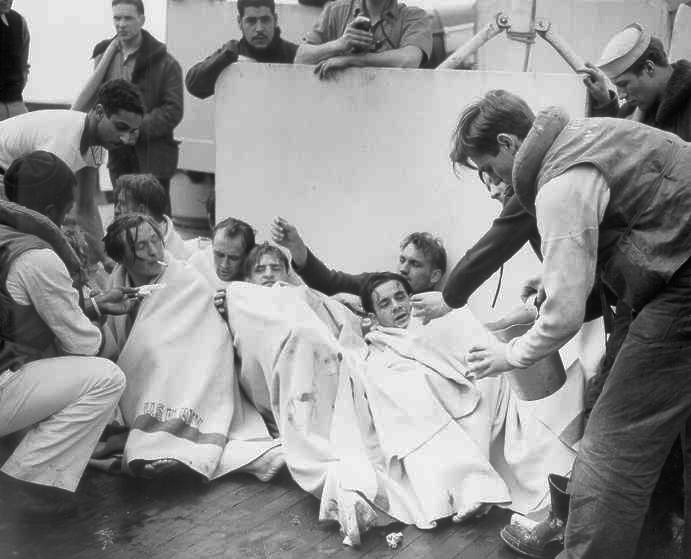
The crew of a sunken U-boat U-171 rescued by her tormentor USCGC Spencer, 17 April 1943. Despite rare occurrences of captains ordering machine-gunning swimming survivors at the surface, and animosity of the allies towards this “cowardly form of warfare” traditional maritime fraternity prevailed. However, survivors of a sinking U-Boats were rare sight as often U-boats carried the entire crew with them to crushing depth when sinking. Others just ran out of breathable air. It was a nasty way to die any case. A new form of inhumanity born from the industry’s twisted fruits.
A painful legacy
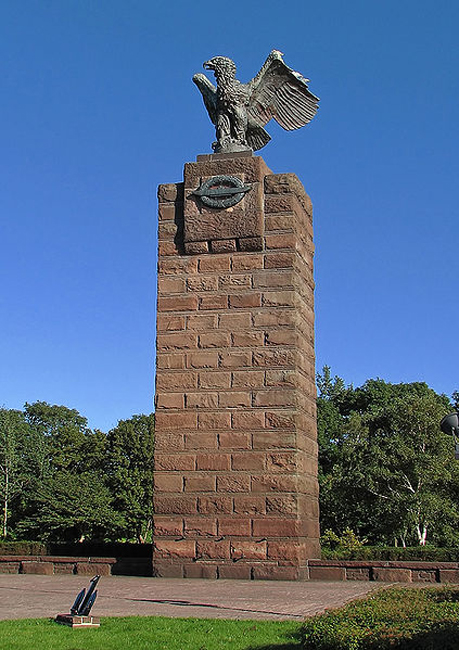
The U-Boot (“Ehrenmal”) memorial at Möltenort, commemorating the 4,744 submariners deads of ww1 and 30,002 dead during ww2, seven times more, while 200 U-boats were lost versus 740 during WW2, “only” three times more. The difference could be partially explained by better allied ASW efficience during WW2, larger crews, but also in many cases also losses on submarine coastal bases, mostly because of allied aviation.
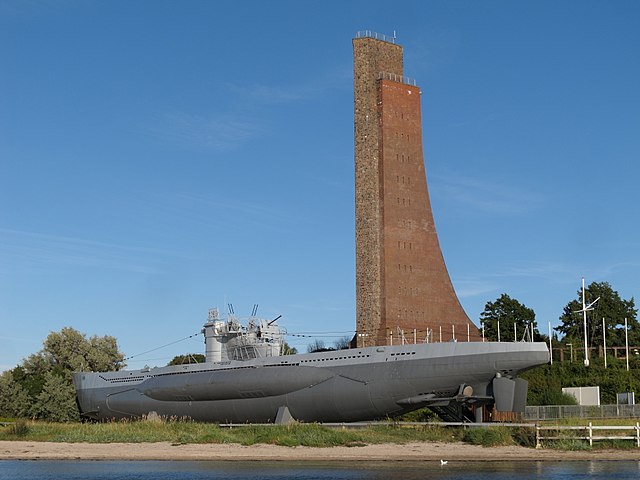
The second German submarine memorial, at Laboe. Behind the preserved Flak-type VII/41 U-995 stand the memorial to not just German submariners but also in general sailors lost at sea by warfare of all nationalities. It was completed in 1936 after being ordered in 1927 by the Weimar Republic, near Kiel, complete with a hall of remembrance and museum, and the U-995 was brought here after the war to dedicate it to submarine warfare. She is the only surviving example, although reconstructions were made for movies like the excellent “Das boot” by Petersen.
Evolution of U-Boat types
However when WW2 broke out, the Kriegsmarine had only about 53 operational submarines in service. Under Albert Speer, the production was rationalized (prefab modules & sections), simplified and extended to many suppliers to dodge allied bombings, culminating in a bunkerized factory for the Type XXI in 1945. Germany also devised the most innovative submarine type during the war, using the close-circuit Walter propulsion, although still largely experimental when the war ended. Compromises were found for two 1944 types that could have changed ASW warfare completely and decisively. We can also add the numerous German midget-submarines that were devised in these last years. So this article is about the U-Boat types, the operational ones and prototypes, up to paper projects, all 26 German submarine types registered in the nomenclature.
U Boat nomenclature 1933-45
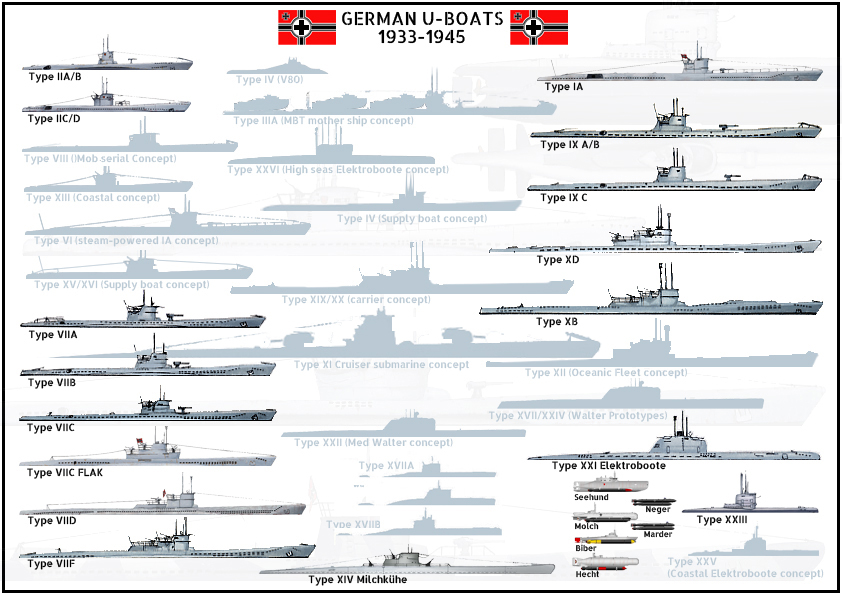
Author’s illustration depicting all types, produced, tested and paper projected of German Unterseeboote during the war. Greyed out profile are approximations based on available information, of paper project or submarines started but never completed (like the Type XXV boats). This does not give the scale of production however.
Submarine Types were generally classed into several categories, although all models until 1945 used the same diesel-electric system but a few experimental Walter system boats. Note that we use the term “submarine” here which is improper: They should be called “submersible” as diving and operating submerged was the exception, the boats cruising on diesels on the surface most of the time. only the Walter close-loop snorkel and propulsion system would have allowed the boats to stay submerged longer.
The main production types were:
- Type II coastal submarines
- Type VII oceanic submarines
- Type IX oceanic submarines
- Type X minelayer submarines
- Type XIV supply submarines (Milkschuke)
Type I U-Boats (1933)

The Class IA U-Boats (Author’s 1/350 scale illu), which was in direct line inspired by the Spanish E1 and various other international orders from Turkey, Finland, designed and/or manufactured at the Hague in Holland. They were oceanic types, openly violating the clauses of the Treaty of Versailles at a time Hitler decided to get rid of it. By their general configuration, they announced the famous type VI, with their standards: Kiosk with reinforced open bathtub and platform for 20 mm AA gun, 88 mm deck gun, 6 torpedo tubes, and MAN Diesels.
But they were little more than pre-production prototypes with only two boats built: the U25 and U26, showing some disappointing characteristics like troublesome MAN diesels, poor seakeeping, and poor maneuverability. They were used for training and propaganda. The first sank 6 freighters and was lost on a minefield (perhaps her own) off the coast of Norway in August 1940. The U26 sank four freighters before being sunk by an escort in July 1940. U1 to U24 series that preceded them were those of Class IIA, coastal submersibles. Read more about the Type IA U-boats
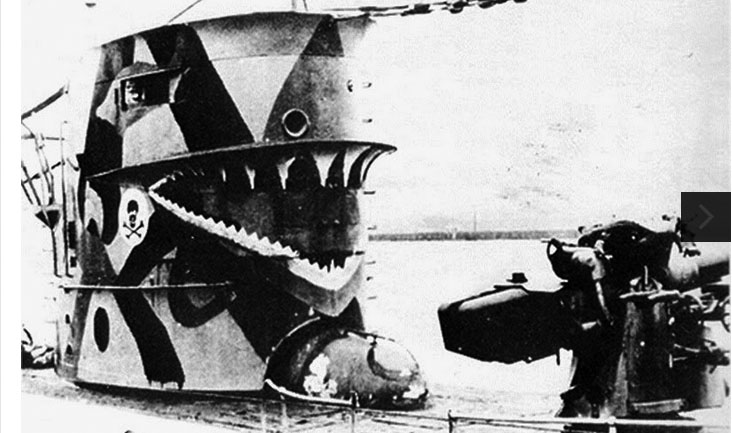
Technical specifications
Displacement & Dimensions: 848t surface/970t dive and 72.40 x 6.20 x 4.30m
Propulsion: 2 propellers, 2 MAN boilers, 2 electric motors, 1540/500 hp. and 17.8 surface/8.3 knots diving
Crew: 43
Weaponry: 1 105mm gun, 1 20mm AA gun, 6 TLT 533mm (4 av, 2 ar, 14 torpedoes)
Type II U-Boats (1933)

Author’s illustration 1/350 U Boat Type IIA-B

Author’s illustration 1/350 U-Boat Type IIC/D
Class II (A, B, C and D), was the first class of “official” submarines in Germany, whose design, started in 1934, openly violated the Treaty of Versailles. In fact they derived from the units produced abroad (in particular Vesikko and Saukko Finnish – project “lilliput”). Modest, they were classified as “coastal”, goods that conceived as oceanic, an ultimate caution intended to make them less “aggressive”, although the allies were only windy in 1935, with the signing of the Anglo-German naval treaty.
But they were de facto too small for the standard oceanic service and in fact they were sentenced to short outings for the whole war: They only loaded supplies for two or three weeks, but rarely used them up, coming home for want of remaining torpedoes. More successful than any other type I, their maneuverability and durability were significantly better. Effectively nicknamed “canoes” by their crews because they were badly treated in bad weather, they were built at the height of 50 buildings until the war. Designed for training, they actually see active service quickly, lack of available submersibles…
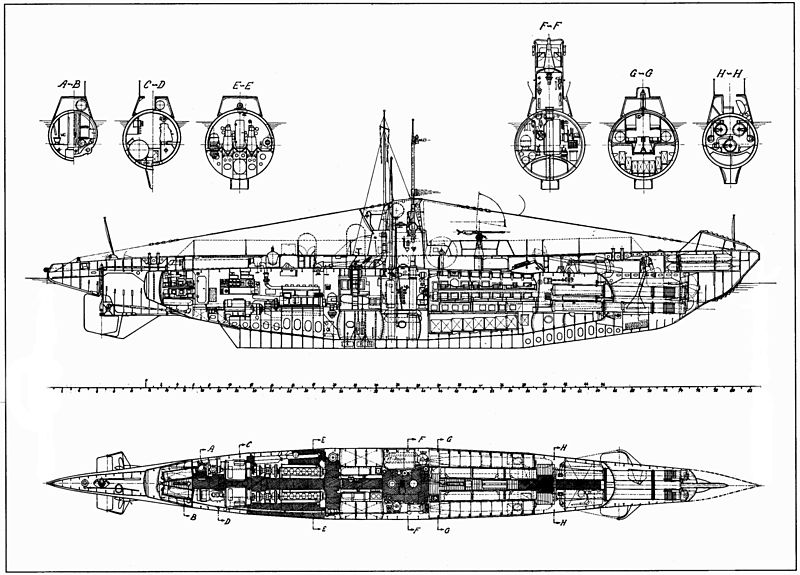 Cutaway of the Type II. More on the Type II coastal U-Boat series.
Cutaway of the Type II. More on the Type II coastal U-Boat series.
The first IA series (U1-U6) had internal ballasts, a small kiosk and an anti-net bow saw, inherited from the First World War. The following type IIB were elongated, their interior fittings revised, and their radii of action higher, as well as their diving speed and submersion speed. Class IIC and IID were still superior in all respects. Larger, much heavier, they had an improved radio, larger ballasts, and also larger tanks, their RA rising to 1900 nautical.
Type D had a standard enlarged kiosk, a 88 mm deck gun, and a 20 mm AA piece on the back deck of the kiosk. Their range was even better, allowing them to roam the British Isles. The C series included the U56-U63 and the D series which entered service during the war, during 1940, included the U137 to U152. These were the last light submarines before the 1944-45 emergency coastal units. Most were lost in operations.
Technical specifications
Displacement: 254t area/301t dive (D: 314/364T, 44 x 5 x 3.9m)
Dimensions: 40.9 x 4.10 x 3.80m
Propulsion: 2 propellers, 2 MWM diesels, 2 electric motors, 350/180 hp.
Top speed: 13 surface/6.9 knots dive (D: 205 hp electric 12.7/7.4 knots).
Misc: Shielding: none; Crew 43; RA: 1050 nautical at 12 knots (3200 nautical miles)
Dive: Crushing depth 100 m; 35 sec. diving speed (C-D 25 sec).
Weaponry: Type C-D: 1 88mm gun, 1 20mm AA gun, All: 3 TLT 533mm (3 av, 6 torpedoes)
Type III U-Boats (1934)
This 1934 project for a purpose-built minelayer was closely based on the Type IA. This Type III had her hull lengthened by 7.5 m, for 970 tons. She was to carry 54 to 75 mines depending on the type, but can also cruise and hunt shipping with two 105-mm deck guns, and AA covered by a 20-mm FLAK gun. The Type IIIA was a planned minelayer similar to the Type IA but with a larger outer hull and a large, watertight cylindrical hangar (aft deck) for two small MTBs plus carried 48 mines, the boats helping laying and recovering mines. However it was soon judged an impractical solution and the program was canceled.
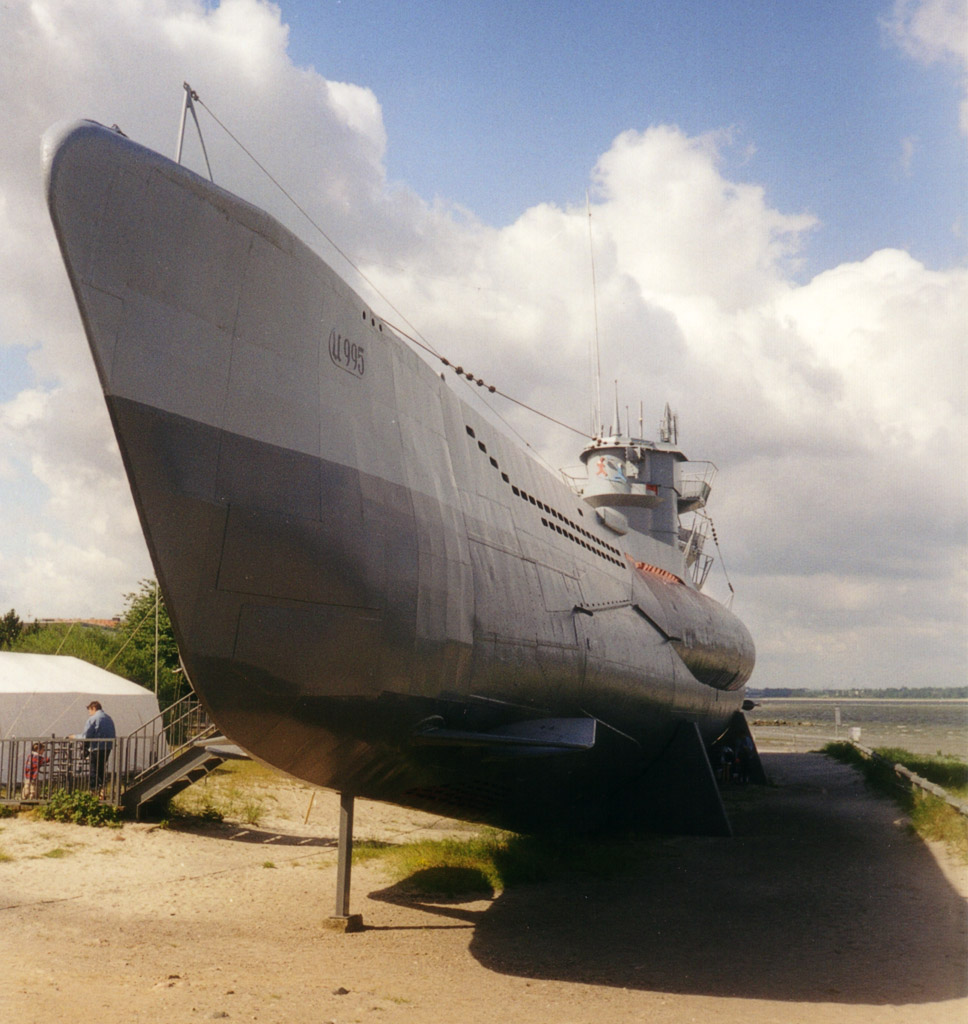 U-995 at Laboe, a late-production Type VIIC/41, the only one of this type that can be visited today, not far away from Kiel and at the foot of the German submarine memorial.
U-995 at Laboe, a late-production Type VIIC/41, the only one of this type that can be visited today, not far away from Kiel and at the foot of the German submarine memorial.
Type IV U-Boats (1936)
These Type IV were resupply and repair models for prolongated sea operations. They would carry torpedoes, fuel, food, water, and spare parts, while also had the staff and material necessary for light repair work, in calm weather. The program was canceled, but many more were projected later on other hulls. The Type XIV was the only one ever operational.
Type V U-Boats (1939)
This was an experimental midget submarine designed by Hellmuth Walter using his hydrogen peroxide-fuelled turbine. Only one experimental boat called the V80 was ever built, but no production of Type V followed as the design was redefined during the war and new types started. She will be seen in detail in a dedicated post.
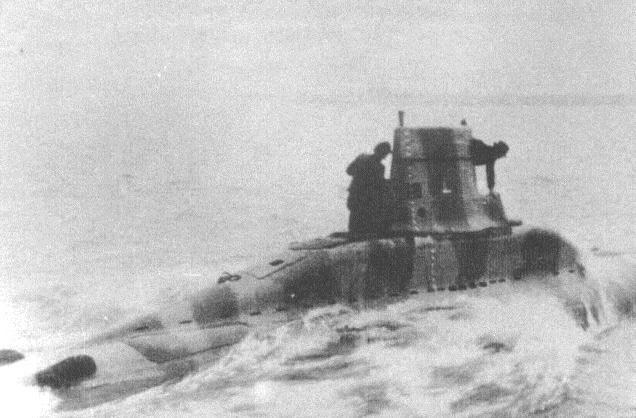
The V80 on trials, camouflaged.
Type VI U-Boats (1939)
Project only: This was a planned conversion of Type IA U-boats to run both submerged and surfaced from steam propulsion.
Type VII U-Boats (1935)
With type VII, the Kriegsmarine touches its “flagship” model, and the legend is born … Type VII will be the most prolific series of submersibles in history, a record never exceeded, with nearly 709 units built, of which many more were never completed, and a considerable number of variants. Type VII alone will be enough to put the British on their knees, or at least it failed to succeed several times during the Battle of the Atlantic and the convoys of Murmansk. Very well balanced, Type VII derived from the mediocre Type I, as a “standard” oceanic, capable of a round trip and stations in the Atlantic for more than two months.
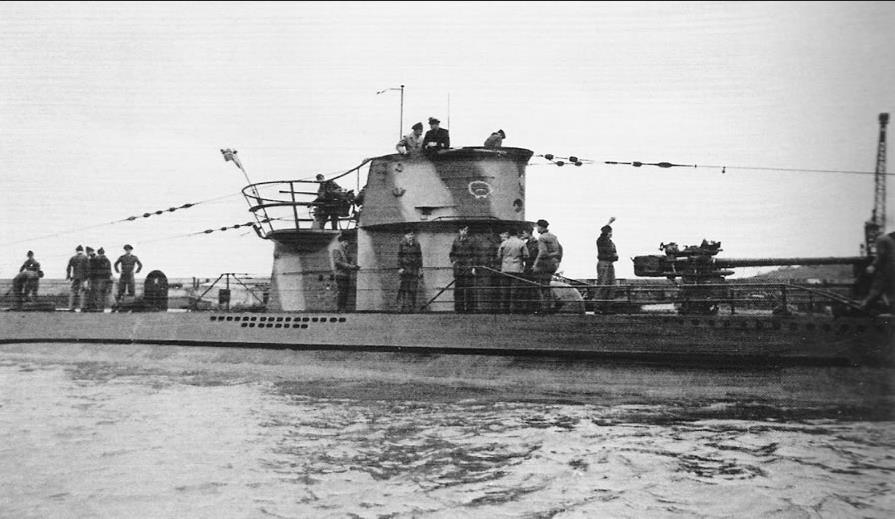
U-202, with only the kiosk camouflaged (light grey band whereas the hull was medium to dark grey.
It was not a complete success at all levels, but was relatively simple to build, reliable, and extremely robust. The crash depth, theoretically 230 meters, was actually often pushed back in practice to 250 meters or more. It was calculated that it was necessary to go down to about 290 meters (variable according to the units whose quality of manufacture evolved to mediocre in 1944) to cause the loss of the building. This result was very honorable because of their design in single hull (all modern submersibles have a double hull), the hull being furnished with lateral reinforcements.
The preliminary drawings went back to 1934, from the beginning a more modest, economical version of the Type I had been considered, and those ones were based on the Spanish E1 and the Finnish Vetehinen. Their construction was welded, they had large ballasts, an effective immersion speed, a double hull and oil reserves giving them a great autonomy, although cargoes anchored in neutral ports were used if necessary. and even “cash cow” submersibles for distant operations (like the US Coastal Campaign in early 1942).
These vessels spent all their time on the surface, except in exceptional cases of very heavy weather, or of course attack, their diving performance remaining mediocre: about 150 km at 4 knots. The reliability of their MAN diesels did a lot for their fame. The latter was a six-cylinder, 40/46 four-valve engine with 2100 to 2300 hp and 470/485 rpm.
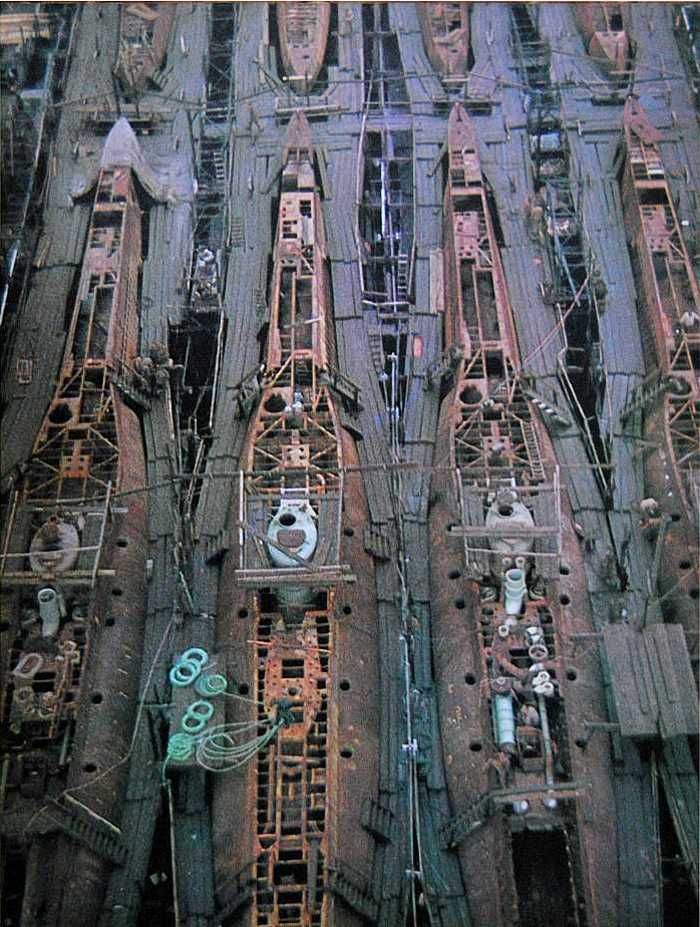
Captured Type VII under construction at the end of the war. Methods used there has been relatively traditional, with simplifications and modularity, but by far the Type XXI modern assembly of prefabricated sections would have been more efficient. (src. Pinterest – no attribution)
The builders of type VII were:
-Neptun Werft, Rostock
-Deschimag, Bremen
-Germaniawerft, Kiel
-Flender Werke, Lubeck
-Danziger Werft, Danzig
-Blohm + Voss, Hamburg
-Kriegsmarinewerft, Wilhelmshaven
-Nordseewerke, Emden
By 1942, construction had begun to be redesigned in modular terms to improve the rate of production. But it is only with type XXI and type XXIII that we arrive at a real “mass production” with a very strong modularization.
Type VIIA

Performances type A evolved thereafter. Ten (U27-U36) Type VIIA were produced in 1936, admitted to active service in 1936-37. They were the cornerstone of the U-Bootes force before entering the war. They were all lost in action.
Technical Specifications
Displacement: 626t surface/745t diving
Dimensions: 64.5 x 5.80 x 4.40 m
Propulsion: 2 propellers, 2 MAN diesels, 2 electric motors, 2100/750 hp. and 16/7 knots surface/sub
Miscellaneous: RA: 4300 nm at 12 knots. Crushing depth 200 m; 22 sec. time diving
Crew: 44
Weaponry: 88mm deck gun, 20mm AA gun, 5 x 533mm TTs (4 ft, 1 st, 11 torpedoes), 22 TMA/33 TMB mines
Type VIIB (1939)

The U-Boote Type VIIB had a slightly elongated hull, larger ballasts and tanks with more capacity. Their range was therefore increased to 4300 nautical miles at a good speed and 6500 miles on cruising speed. A system of hyperalimentation of the diesels made it possible to gain a knot in emergency situations.
Finally the torpedo capacity was increased to 14, stored in the upper part of the pressure hull, a clear advantage which greatly increased their duration of operation. Finally thruster boosters were added, improving maneuverability and freeing up space for the rear torpedo tube that could now be accessed from the inner hull (and thus reloaded). 24 units of these excellent boats, produced and improved by the first experiments in operations, were accepted in service in 1939-1940. They formed the basis of the famous variant C.
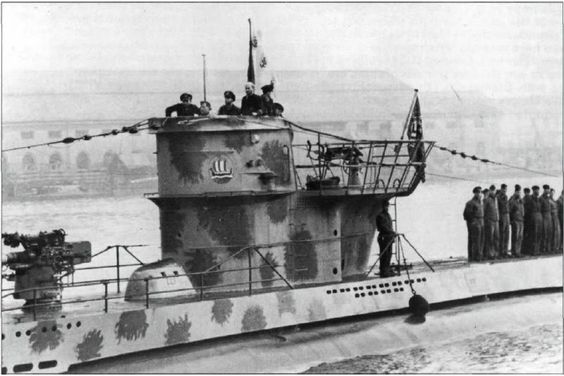
U-83, Type VIIB with a rare spotted camouflage, operating from La Spezia in 1942.
Technical specifications
Displacement: 753t surface/857t dive
Dimensions: 66.5 x 6.20 x 4.40 m
Propulsion: 2 propellers, 2 MAN diesels, 2 electric motors, 2100/750 hp.
Top speed: 17.2 / 8 knots surface / dive
Range: RA: 6500 nautical at 12 knots,
Diving performances: Crushing depth 200 m; diving time 22 sec.
Weaponry: 1x 88mm gun, 1x 20mm AA gun, 5 x 533mm TTs (4 av, 1 ar, 14 torpedoes), 26 TMA/39 TMB mines
Crew: 44
Type VIIC (1940)

Illustration of the sub-type VIIC FLAK
The following U-Boote type VIIC brought to its pinnacle the formula of the average oceanic submarine. Derived narrowly from type B, they had an additional central space enlarged by 60 cm to house a sonar of a new type. The oil filter, the air compressor, and the electrical distribution system were more modern and improved. But their construction remained close to type B, which facilitated their production. A total of 577 (568 or 593 according to other sources) units were acquired in service, which remains an absolute record for this type of building (just behind are the 236 “Whiskey” Russians, then the “Gato” Americans). They were produced until 1945, 150 being yards on the day of surrender, and formed the workhorse of operations in the Atlantic.
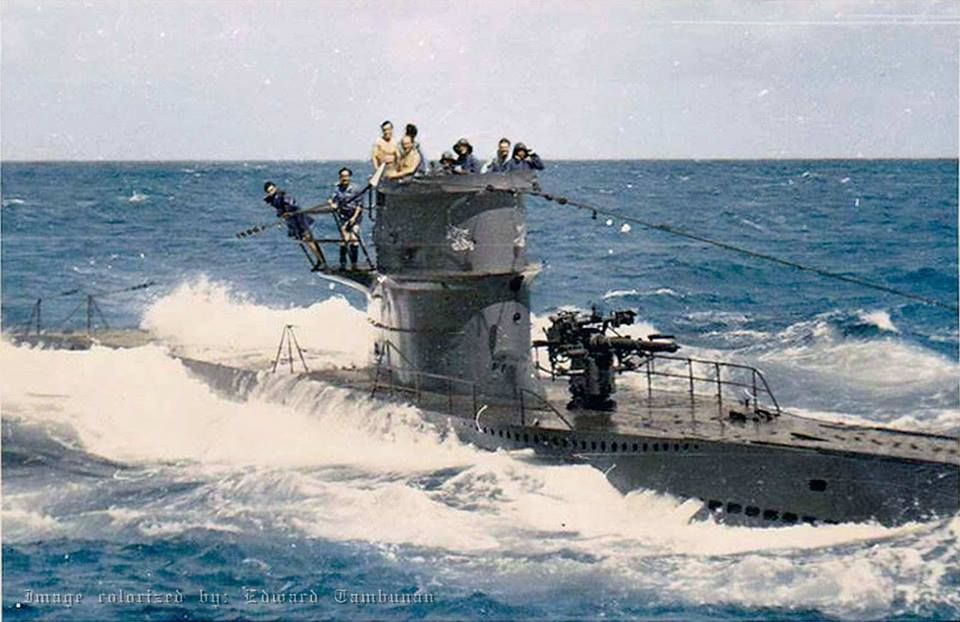
U-96 colorized by Edward Tambunan
Numerous variants were derived from it, notably the supply variants (with only two TLTs at the front) and the famous “U-flak” variant, U for “unterseeboote”. The latter (image) were four units equipped with a 37 mm gun and two 20 mm Flakvierling quadruple carriage. They provided aerial coverage of the pack on the surface. In 1943 their success was short-lived when the RAF had its planes operated in concert with fast escorts … They derived from the previous U256, converted in 1942.
With the latter, we tried a battery of 86mm AA rockets, but the concept was not followed. These “Flak U” only downed six aircraft and soon returned to their classic role. The air supremacy of the RAF and Coastal Command in the Bay of Biscay made these attempts hopeless. Dönitz was reduced to asking her submariners to cross this zone at full speed to go to the center of the Atlantic (where the air cover stopped), even reducing their autonomy.
Many C-types survived the conflict, most were given as compensation to allies, some being exposed, others sailing for the film as the U96 which served the famous Petersen film, “Das Boot”. They were followed by variants C/41 and C/42.
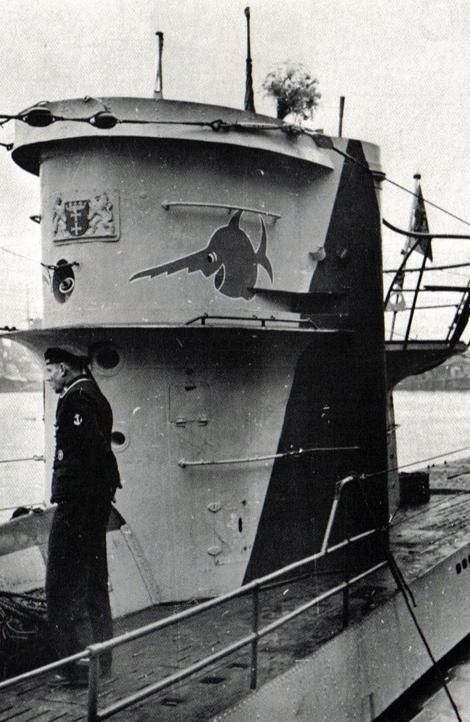
U-96 kiosk, which served as a model for a partial replica for the movie “Das Boote” in 1981.
Technical specifications
Displacement: 761t area/865t diving
Dimensions: 67.2 x 6.20 x 4.80 m
Propulsion: 2 propellers, 2 Germaniawerft 40 diesels with compressor, 2 electric motors, 2100/750 hp
Top speed: 17.2/7.6 knots surface/sub
Crew: 44
Miscellaneous: 6500 nautical miles at 12 knots,
Dive: Crushing depth 200 m; Diving time 22 sec.
Weaponry: 1x 88mm gun, 1x 20mm AA gun, 5x 533mm TTs (4 av, 1 ar, 14 torpedoes), 26 TMA/39 TMB mines
Type VIID (1942)

1/350 Illustration Type VIID
The U-Boote type VIID was an enlarged version of the VIIC type, with a length of 76.90 meters and a width of 6.40 m, to accommodate 5 large vertical tubes placed behind the kiosk, and intended to accommodate 15 heavy mines SMA additional (three per tube). They had been conceived in the express design of anchoring mines in front of the great ports of the American coast. DCA was also reinforced, with a 37 mm AA cal 83 C30 gun and a fast 20 mm c30 gun.
Six units were launched at Krupp, Germaniawerft and operational in 1942, one of which effectively undermined the entrance to New York Harbor. All but one, the U218 (surrendered to the US Navy in 1945) were sunk on mission. Type VIIE was an experimental model with a new, lighter and more powerful V12 diesel model, allowing a thicker hull for deeper dives. But the engine was too much trouble and the program ended in a dead end.
Technical specifications
Displacement: 965t area/1080t diving
Dimensions: 76.9 x 6.38 x 5.00m
Propulsion: 2 propellers, 2 Germaniawerft 40 diesels with compressor, 2 electric motors, 3200/750 hp.
Top speed: 16.7/7.3 knots surface/dive
Crew: 46-52
Miscellaneous: RA: 11,200 nautical miles at 12 knots
Depth: crushing 200 m; lives. plunged. 22 sec.
Weaponry: 1x 37mm gun, 1x 20mm gun, 5x 533mm TTs (4 av, 1 ar, 12 torpedoes), 41 TMA/39 TMB mines
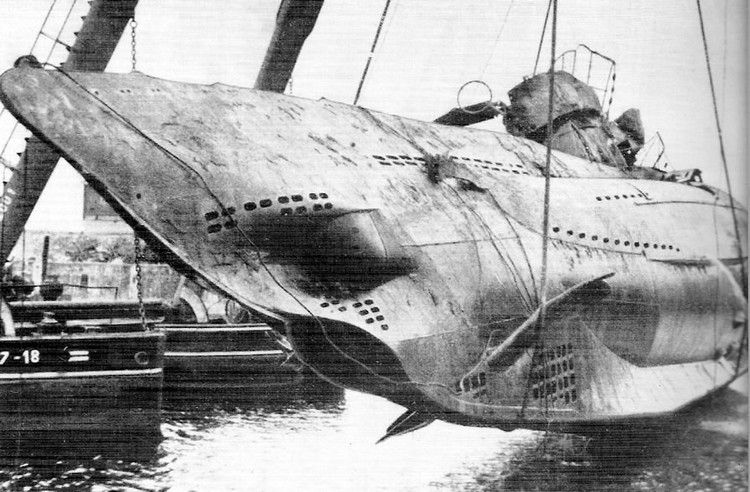 Recovery of an unidentified U-Boat
Recovery of an unidentified U-Boat
Type VIIF (1943)
The U-Boote type VIIF was a modified version of the type VIID, with vocation of supply ships at sea. In 1942, most of the cargo ships German Germans for the Atlantic had been lost and one dared risk more the last ones face in particular with the RAF and soon to the US navy.
As a result, “submarine cargo ships” were designed with an additional section of nearly ten meters behind the kiosk to house torpedoes, more than ammunition, fuel and food. The capacity of these vessels was reduced to two refueling, after which their own offensive cruising could take place. Their 88mm cannon was later ceded to a 20mm double holster on a rear extension of the kiosk. These were the U-1059, 1060, 1061 and 1062, all lost at sea except the U1061, captured at dockside by Allied troops in 1945.
In practice the torpedo raiding at sea proved slow and laborious, dangerous both that the operation was not over and demanding a mild weather, rare in the Atlantic. From 1944, they served as cargo ships, from one port to another, as in Japan to deliver new models of torpedoes …
Technical specifications
Displacement: 1067t surface/1162t diving
Dimensions: 77.60 x 7.30 x 4.90 m
Propulsion: 2 propellers, 2 MAN diesels, 2 electric motors, 2400/750 hp.
Top speed: 16.9/7.9 knots surface/sub
Crew: 46
Miscellaneous: 9200 nautical at 12 knots,
Diving: Crushing depth 200 m; diving speed 22 sec.
Weaponry: 1x 88mm gun, 1x 20mm AA gun, 5x 533mm TTs (4 av, 1 ar, 14 torpedoes), 26 TMA/39 TMB mines
Type VIIC/41 et VIIC/42 VIIC/43 (1942-45)
The U-Boote Type VIIC/41 to 43 were variants of the most prolific submersible class in history, a synthesis of modifications and improvements inspired by the experience of war operations since 1939. For Type VIIC/42, the urgency was to allow the building to dive deeper. With a shell reinforced by a wall of 18 to 21 mm in places, it became possible, but at the price of the sacrifice of all that was not necessary, a weight reduction that made lighter boast than the origin, and can dive to 250 meters (see much more in practice). 88 units of this type were built. During the war, their single 20-mm Flak lookout was replaced by a double, and their 88-mm piece, which had become useless as the naval superiority of the Allied surface was overwhelming, was dropped.
Subsequently, type 42 (modification approved at that date), combined this weight reduction with a new compressed diesel allowing a record autonomy of 10 000 nautical miles at 12 knots, the surface speed rising to 18.6 knots and especially the shell expanded and machined with reinforced steel normally used for armor plates, having in places 28 mm. These modifications would have allowed a theoretical immersion depth of 500 meters…
None of the 165 authorized units was ever completed. Most were captured by the allies under construction in April-May 1945. Type VIIC / 43 never passed the stage of the drawing board. This was Type 42 with additional torpedo storage space and no less than 10 torpedo tubes, 6 front and 4 rear.
Technical specifications
The following characteristics relate to type 41:
Displacement: 759t surface/860t diving
Dimensions: 67.20 x 6.20 x 4.80 m
Propulsion: 2 propellers, 2 MAN diesels, 2 electric motors, 2400/750 hp. and 17/7.6 knots surface/sub
Crew: 44
Miscellaneous: 6500 nautical at 12 knots,
Crushing depth 250 m; lives. diving speed 18 sec.
Weaponry: 1x 88mm gun, 1x 20mm AA gun, 5x 533mm TTs(4 av, 1 ar, 14 torpedoes), 26 TMA/39 TMB mines
Type VIII (1935)
Little information is available on the Type VIII U-boat, other than it was planned for production in the event of mobilization in 1935. we can guess they were based on the largely available Type II and possibly enlarged and simplified fo greater production.
Classe IX long range submarines (1938)
The U-Boote type IX A was the first of the prolific class IX projected from 1934. It was a “submersible cruiser” a concept drafted during the first world war. Emphasis was placed on autonomy, which included greater dimensions for storing fuel oil. It was also envisaged to use them as squadron leaders in the “wolf pack” operational framework, including powerful transmission means and additional space to serve as a floating HQ and coordinate attacks. The fall of France and establishment of a major HQ operations on the Atlantic coast in Lorient made this role useless.
The Type IX, developed with care, was more effective than type VII, which could cross literally everywhere, with a greater mission duration because of large stocks of torpedoes. They took however longer to dive, maneuvered less well, and were more visible once submerged because of their size. These points were improved later. They also had a more powerful diesel with 9 cylinders and compressor, and a true double hull, allowing for deeper dives. In addition, their wide deck allowed the housing of no less than 10 additional torpedoes, stored in watertight compartments, accessible for the surface. More than 200 U-Bootes of this type, much more expensive, were launched until 1944, with no less than 7 variants…
 u-109, of the Type IXB colorized by Edward Tambunan
u-109, of the Type IXB colorized by Edward Tambunan
The Type IXB had greater autonomy thanks to an increase in its storage space
The Type IXC increased the storage capacity to 208 tons, allowing a whooping autonomy of 11,000 nautical miles, and the IXC/41 to 214, even 400 more nautical miles. 54 and 87 boats respectively of these versions were built, making the backbone of the first part of the Battle of the Atlantic along with the VIIC.
The Type IXD-1 (U180 and U195) were an experiment, equipped with two Daimler Benz MB501 diesels giving a comfortable speed of 20 knots when surfaced. But smoke and excessive heat made them visible from afar and they were later converted back to their classic MANs. The U-195 was converted into a cargo, accommodating 252 tons. Both were using a Focke-Archelis FA330 Bachstelze glider autogyro to spot targets on the horizon. This kind of machine, close to a helicopter, was devoid of engine, the launching of the blades being done by hand, and the machine remaining guided by using a cable.
The Type IXD-2 (28 boats) focused on enhanced autonomy, with a higher capacity and especially two additional diesels specially designed for economic cruising, as well as weight savings. These units had the best range of German U-Boats, with no less than 23,700 nautical miles. The D-2/42 in 1943 experimented some detail improvements, but only one of tis last serie, the U882, was built. All boarded an autogyro FA330. The whole Program IX was stopped in favor of easier and faster units to mass-produce, and revolutionary models (like the Type XXi and XXIII elektroboote).
Technical specifications
Characteristics related to type IXC/40 (1941)
Displacement: 1144t surface/1257t sub
Dimensions: 76.80 x 6.90 x 4.70 m
Propulsion: 2 propellers, 2 MAN diesels, 2 electric motors, 3200/470 hp.
Top speed: 18.3/7.3 knots surface/sub
Crew: 48
Miscellaneous: 11,400 nautical miles at 12 knots,
Crushing depth 200 m; diving speed 22 sec.
Weaponry: 1x 105 mm gun, 1x 37 mm, x 20 mm AA, 6x 533 mm TTs (4 av, 2 ar, 22 torpedoes).
Type X minelayer submarines (1942)
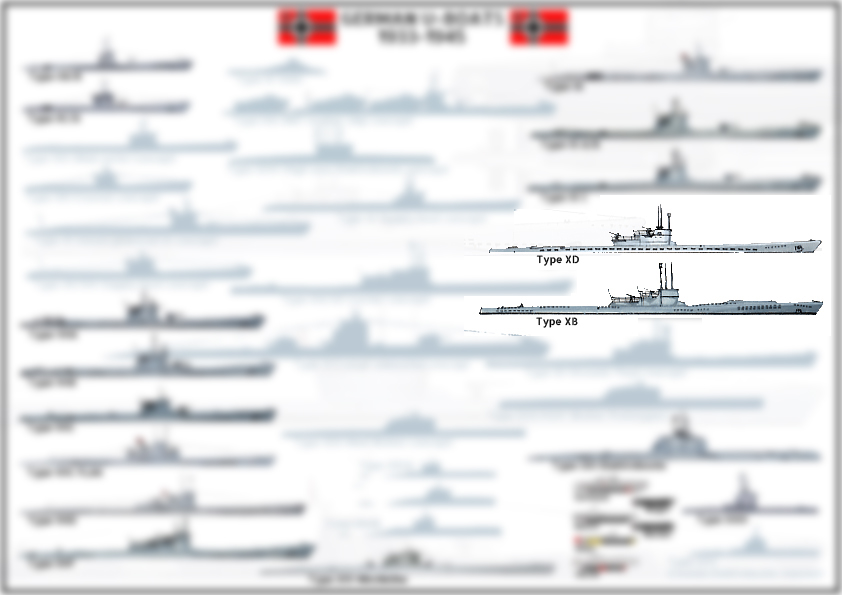 The Type X was directly derived from the unique IXD-2/42. They were designed to anchor mines on the American coastal areas in 1942. Their draft was notably lower to get closer in shallow waters and they had been deprived of their forward torpedo tubes and refills. With nearly 1,800 tons underwater, they were the largest operational German submarines of the war (but not the heaviest, see below).
The Type X was directly derived from the unique IXD-2/42. They were designed to anchor mines on the American coastal areas in 1942. Their draft was notably lower to get closer in shallow waters and they had been deprived of their forward torpedo tubes and refills. With nearly 1,800 tons underwater, they were the largest operational German submarines of the war (but not the heaviest, see below).
Two sections were added (front and rear) to stack more SMA mine tubes, bringing the total to 66 mines total. Eight boats were launched in the fall of 1942, designed to operate in particular off New York and San Francisco. Unfortunately for them, the “golden age” of operations on the US coast was already over, and the Americans were much better organized and equipped. Only one, the U219, was present in the Pacific at the capitulation, passed on the Japanese side, and she went on soldiering for the IJN as I-505, until August 1945…
Technical specifications
Displacement: 1590t area/1775t sub
Dimensions: 89.80 x 9.20 x 4.70 m
Propulsion: 2 propellers, 2 MAN diesels, 2 electric motors, 2100/550 hp.
Top speed: 16.4/7.3 knots surface/dive
Crew: 52
Miscellaneous: RA: 12,000 nautical miles at 12 knots
Crushing depth 200 m; diving speed 22 sec.
Weaponry: 1x 105mm gun, 1x 37mm, 1x 20mm AA, 2x 533mm TTs (aft, without refill), 66 mines SMA.
Type XI cruiser submarines (1939)

Author’s 1/750 rendition profile of the Type XI compared with a VIIA.
These fascinating boats would have been submarine leviathan, the largest in service before the introduction of the Japanese aircraft carrier models I-400 in 1944. Their goal was to hunt trade using the same WWI canceled projects and allied interwar concept of gun-armed large oceanic types such as the French Surcouf. They were also artillery boats with a main armament of four 128-mm guns, in two twin turrets. Gunnery setup and recce would have been performed by an onboard Arado Ar 231 collapsible floatplane.
Eventually, blueprints were approved and four were ordered (U-112, U-113, U-114, and U-115), laid down in 1939, but cancelled when the war broke out because of other priorities, and material was recycled. They were designed with a new pressure hull for greater dives and a record-breaking tonnage of 4,650 tons equivalent to a light cruiser. The Type XI was designed to engage escort vessels in artillery duels at long range, and diving for safety if ships were to retaliate. If they would have been indeed built, both their very long range and armament was more than a match for many escort ships such as the British Flower corvettes, River/Castle Frigates or American PC-chasers.
Type XII (1938)
This Type XII listed as an “Advanced Fleet Ocean Boat” was designed in 1938 to carry eight torpedo tubes, six at the bow and two at the stern, for 20 torpedoes in storage. Gun armament was to be the same as for the type IX. Designed with roughly the same hull and lenght of the IXD they had more powerful engines and electric motors for faster speeds both on surface and underwater. However, no contracts was awarded and the project stayed on drwaing boards.
Type XIII (1939)
The Type XIII was a coastal type boat, a further development of the type II with four torpedo tubes and one 20-mm AA Flak gun. They stayed at the drawing stage as ASW warfare at this point shifted from a defensive role to an active oceanic stage.
U-Bootes type XIV “MILCHKÜHE” (1941):
The Type XIV U-Boote was a supply type for other submersibles at sea, one of the keys to the pack tactic developed by Dönitz, planned in 1934 already. Unfortunately, the type IV that was born from this idea was never realized because of the limitation of tonnage allocated to German submersibles by the Anglo-German Treaty of 1935, by then still respected. As a result, Dönitz had to wait until 1939 for all the limitations to be lifted and to consider a submersible of nearly 2,000 tons.
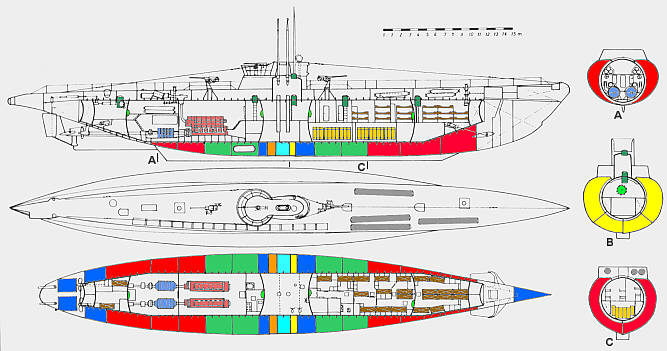
Type XIV came out of drawing boards in 1940, being essentially a very modified Type VII. Unloaded from practically all its armament, which was limited to the AA armament, the type XIV put the accent on loading capability, with proportions of a “barrel”, large width and draft, making it possible to house massive amounts of oil and hard supplies for long missions, in particular food and torpedoes. There was also a bakery on board, producing fresh bread and an operating room with a doctor. The presence of one of these u-bootes within a group of operation, a “pack”, extended its operational duration twofold and was one of the keys to their planned success. Nevertheless, the small number of units and their limited capacity mitigated their effectiveness on the Atlantic campaign, not to mention the difficulty of the refueling operations themselves.
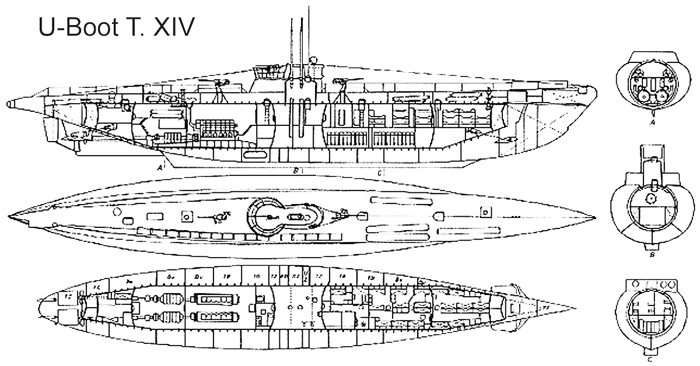
Nicknamed Milchkuh (“milk cows”), these units were built up to only 10 boats, for a total of 24 planned. Allied intelligence eventually took notice and placed them at the head of their hunting board. As a result, operational boats between November 1941 and March 1943 were all sunk, including three on their first mission. They rendered great service during their short operational career. It was envisaged that Type IX would be transformed into large supply boats in the same way, but this project ran out of support eventually.
Technical specifications
Displacement: 1668t surface/1932t
Dimensions: 67.10 x 9.40 x 6.50 m
Propulsion: 2 propellers, 2 MAN diesels, 2 electric motors, 2100/550 hp.
Top speed: 14.4/6.2 knots surface/dive
Crew: 53
Miscellaneous: 9300 nautical at 12 knots,
Crushing depth 240 m, diving speed 22 sec.
Armament: 2x Flak guns 37 mm, 1x 20 mm AA.
Type XV/XVI (1940)
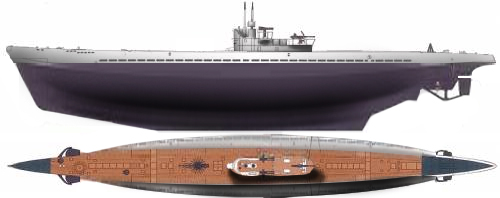 Author’s modification of a Type X to attempt a rendition of the Type XV (1/750)
Author’s modification of a Type X to attempt a rendition of the Type XV (1/750)
Both types were closely related as they shared the same designed hull with different internal arrangement, same powerplant and general features. The 5,000-ton Type XV was left in Initial designs only and listed on official documentation as “Long Range Transport Boat” but never developed and past the stage of first sketches. The Type XVI was intended as a very large repair boat variant (3,000-ton) intended to carry torpedoes, food, and oil as cargo. The engine layout was inspired by the Type VIIC. It was never developed further.
Type XVII/A/B/C (1942-44)
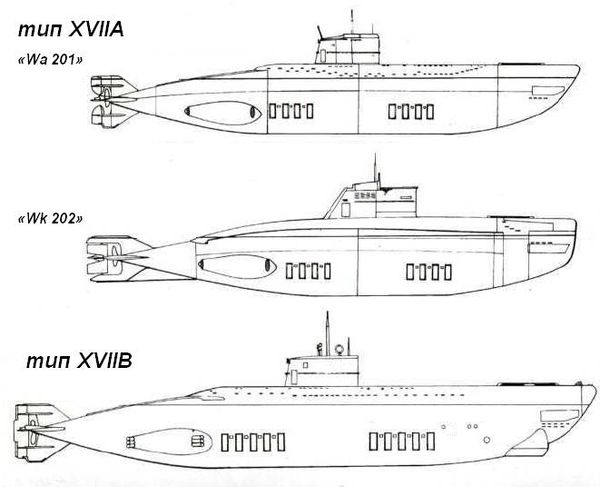 These boats were among the few operational during the war as seven in total has been ordered and built. They were all small, fast attack boat with an innovative chemical propulsion system. Four model XVIIA were built in 1942 and used operationally. Three XVIIB were ordered in 1943 as upgraded version of the XVIIB with slightly better abilities, also operational. The third type, XVIIG of 1944 was an ever further upgraded version ordered but never completed and deployed. The Type K was a 1944 prototype using a closed cycle diesel engine submarine which never advanced past initial designs.
These boats were among the few operational during the war as seven in total has been ordered and built. They were all small, fast attack boat with an innovative chemical propulsion system. Four model XVIIA were built in 1942 and used operationally. Three XVIIB were ordered in 1943 as upgraded version of the XVIIB with slightly better abilities, also operational. The third type, XVIIG of 1944 was an ever further upgraded version ordered but never completed and deployed. The Type K was a 1944 prototype using a closed cycle diesel engine submarine which never advanced past initial designs.
Type XVIII (1943)
 “What-if” Rendition of Type xviii U796 by buonantuono, modified by me (3d and fatigue)
“What-if” Rendition of Type xviii U796 by buonantuono, modified by me (3d and fatigue)
This U-boat was a project for an attack model using the Walter propulsion system. Only two, U-796 and U-797 were laid down in 1943. Construction however was cancelled in March 1944. In many aspects they precluded the famous Type XXI, albeite smaller and lighter. The whole complexity of the Walter system would have doomed any scale production of reliable boats before the end of 1945.
Type XIX (1943)
This was anoyher project that stayed in Initial designs stage only. Listed as “Long range mine layer” but also designed as unarmed transport U-boat, based on the Type XB mine layer.
Type XX (1943)
A paper project of a “Long range transport boat”. This was a transport U-boat based on the Type XB but with a shorter hull width a much greater beam and draft. Thirty of these were laid down in 1943. However construction stopped in 1944 and by August, for the first three (U-1701, U-1702, and 1703) construction resumed only to be stopped in early 1945 and the whole program canceled. The appearance would have been close to the Type XV/XVI.
Type XXI (1943)
 Artists’s impression from a model kit
Artists’s impression from a model kit
The XXI types could have changed the course of the Battle of the Atlantic. In 1942, the losses of the VIICs, whose conception dated back to 1936, became more and more heavy in front of the impressive means implemented by the allies.
In 1943, Allied superiority was overwhelming, and every U-boat trip in the Atlantic was at a very high risk, with crews often young and inexperienced. A parade existed, however: A model then experimental that Professor Helmuth Walter advocated since 1931. Submersible technology had changed little since the end of the Great War, with the latter spending most of their time on the surface, diving only in case of emergency, and becoming slow, blind, at the mercy of sonars and depth charges. Renewing the air or expelling surplus acid gases generated by the use of batteries caused “broths” detected for miles around the surface by planes on patrol, while the slightest noise on board betrayed their presence to more and more sophisticated hydrophones, not to mention their radar signature on the surface.
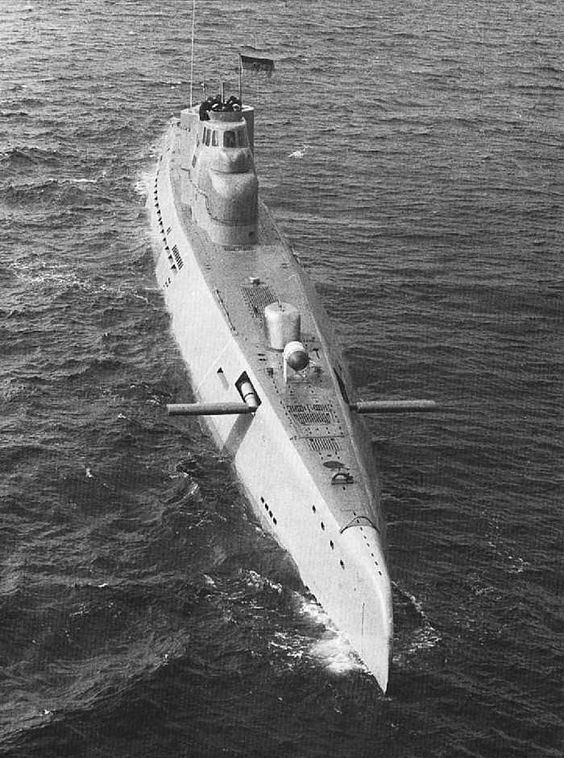
Professor Walter had patented a motor fuel system that uses nitrogen peroxide, a very unstable product that had the advantage of allowing these engines to remain completely autonomous, with little or no vibration, and above all to stay in operation. Dive almost indefinitely, at high speed. This revolutionary process quickly interested the Nazis, who commissioned a first project in 1933.
However the rearmament priorities lowered this program, and it was postponed. It was not until 1939 that the first “Walter Propulsion” submarine was built. The V80, weighing 75 tons and 22 meters long, thanks to its refined hull shape, easily reached 28 knots submerged, an absolute record at the time, only beaten with the 1960s SSNs of the cold war. The following V300 followed in 1942, inaugurating a high-pressure turbine. She started as the first operational submarine in 1943, the U-791, giving birth to the U-792 and 793, 794 and 795, armed with forward torpedoes, which went through month of gruelling operational service.
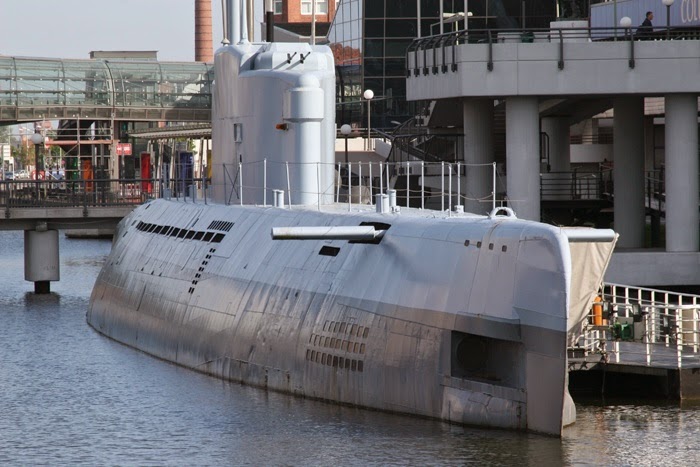
But this research progressed very slowly, and priority was given to a simpler model eventually, the type XXI, marrying the new hydrodynamic hull resulting from the advanced researches in this field (with large models in test pools), with a more conventional diesel, but incorporating a much higher provision of batteries, which passed their power to a final speed submerged reaching 17 knots, and an autonomy of 220 miles submerged at economic speed…
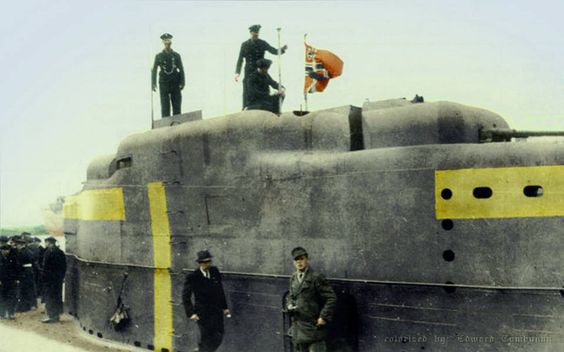
U3034 Kiosk in 1945.
They also received a anti-vibration system that made them completely silent at low speed when diving, and the first of its kind (now mainstream on all submarines), magnetic jammers against Deep-Charges, and especially a scnorkel that allows a constant air flow without surfacing, at constant depth (constrained by the height of the device)
but also released oil to make believe the observer of a successful grenade attacks, a high-speed automated torpedo launch system, magnetic-headed torpedoes, and brand new semi-automated anti-aircraft systems in electric turrets coupled with new listening and detection systems. It was an amazing feat of visionary engineering, the likes of which percolated through cold war submarine design for dozens of years. In fact, the XXI overall design was still relevant in 1965.
 Original blueprints, converted into white/black for better view
Original blueprints, converted into white/black for better view
Albert Speer organized mass production with great efficience, so that the first series would be operational in November 1944. Prefabricated sections were used (see below schematics), that could be built ashore in tunnels, blockhouses, underground sheds, then transported by boat in immense Block-building sites made by Todt, for final assembly and capable of producing hundreds of them in a month at the edge of large rivers. Authentic “secret weapon” in the same way as the V2, the Me 262, Horten flying wing, and the new Königstiger, one melted inordinate strides on their success.
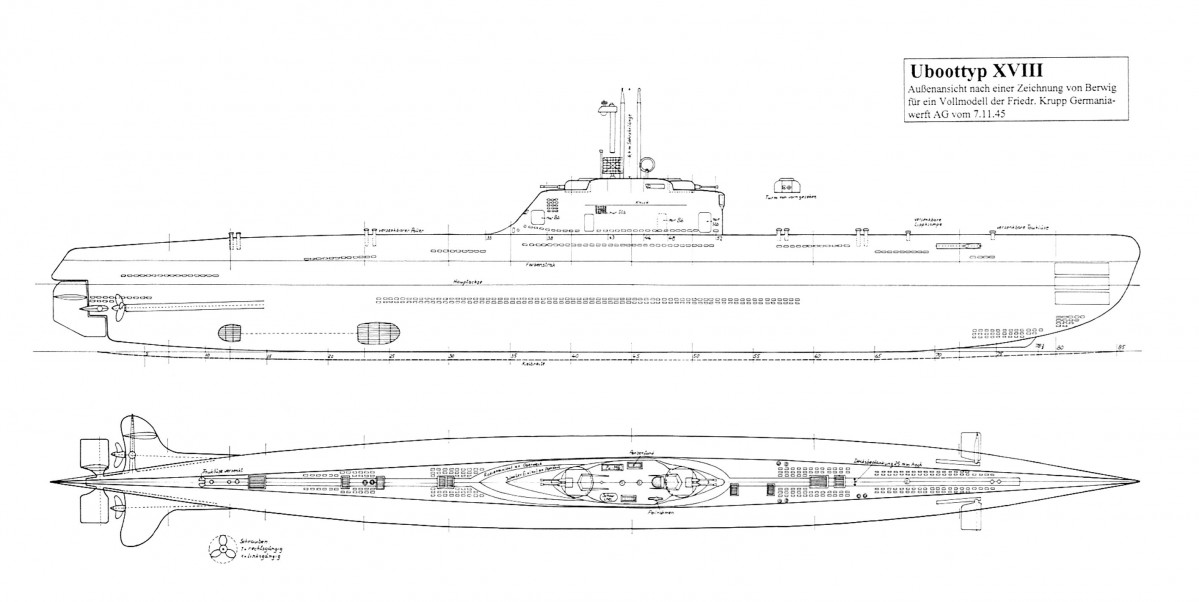
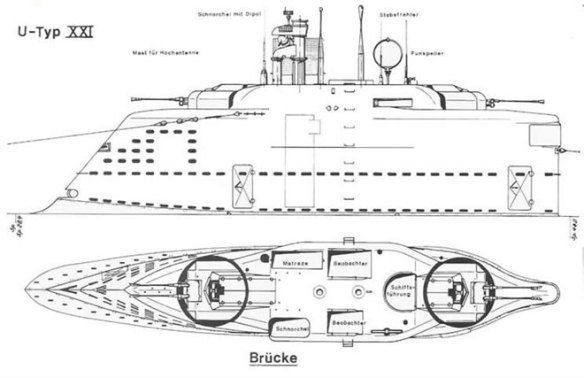
However on the Atlantic it was too little, too late, and the XXI did not change the course of the war. From 1600 originally planned for the end of 1945, only 121 will be completed, and of this total a small proportion gained operational bases in Norway, and from there only two, the U-2511 and U-3008 made an operational missions, the others remaining at the dock waiting for orders that never came. The staff itself was caught off guard with these units because it lacked months of training and reflection for the definition of a radically new tactic. These XXI types were present in large stocks at V-day, in which the allies plundered generously. The Russians, in particular, are known to have “plagiarized” them most openly, and they will constitute the basis of the new models of conventional attack Submarines of the 60s.
 Modular prefabrication schemes
Modular prefabrication schemes
Gallery of Type XXI photos:
https://www.pinterest.fr/brian7100/type-xxi-u-boat-the-elektroboot/
Type XXII (1943)
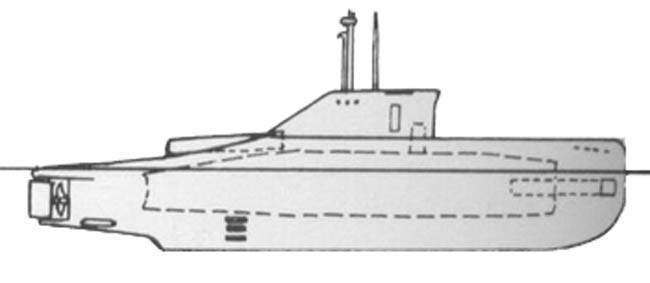
A Coastal submarine type, with only two prototypes U-1153 & U-1154 built at the end of the program. U-1153 was laid down on September 30, 1943, but the contract was canceled on November 06, 1943. The “Advanced coastal boat” was rather short and stubby (see picture), intended for coastal and Mediterranean use. They used the Walter propulsion system. The crew waslimited to a couple of officers and 10 men. Three torpedo tubes, with two at the bow and one aft was all their armaùent, with limited refills. The program noted the delivery of 72 contracts to Howaldtswerke (in Hamburg and Kiel) of which only two were delivered. The stituation quickly deteriorating in the Mediterranean change priorities. It was not specified if the boats had to pass through Gibraltar or were to be assembled locally after shipping them by rail and sections.
Dimensions: 27.1 x 3 x 4.2 meters.
Surface displacement: 155 tonnes at 7 knots
Diving Speed: 20.1 knots
Propulsion: 1 x Diesel 12 cylinders Deutz R12 V26/340
1 x Walter turbine 1850 hp Electrical: 1 x 77
Gas-Oil capacity 12 tons + 30 tons of H2O2
Armament: 3 torpedo tube 3 refills
Range: 1150 nautical miles in Surface at 6.5 knots, 96 nautical miles in Diving at 20 knots
Crew: 12
Type XXIII (1945)
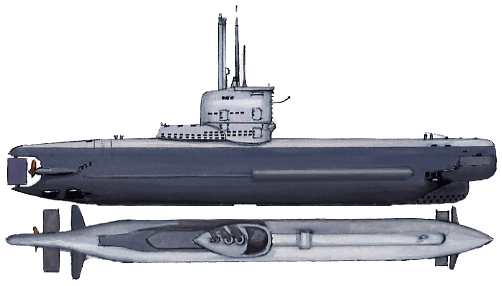
1/350 Illustration Type VIID
Conceived on the same basic request as the Type XXI, Types XXIII were a simplified coastal version. They were to be commissioned in 1944-45 by the thousands, produced in prefabricated sections and launched from the same gigantic factories under bunkers on the great German rivers.
In particular, they had only one engine similar to that of the XXI type, but with dimensions and tonnage giving them excellent performance, better than the XXI. They were in fact the fastest submarines worldwide at that time, reaching speeds unheard of for years to come.
Their limited area of operations included the British Isles. Their internal dimensions were so small that they only loaded two torpedoes in addition to those already housed in their tubes, which limited the duration of their mission.
In the end, 61 boats were commissioned (out of more than 300 planned, later discovered in completion or laying in sections), six of which were able to operate around the English coast in January-March 1945. Scuttled shortly before the capitulation, none was sunk in action. Unlike Type XXI, their extreme concept did not influenced future development of conventional attack submarines. They were a “viable” complement to the innumerable micro-submersibles built in mass at the end of the war, whose fate was written in advance.
Technical specifications:
Displacement: 234t surface/ 275t submerged
Dimensions: 34.60 x 3.40 x 4.30 m
Propulsion: 1 propeller, 1 diesel MAN, 1 electric motor, 1 schnorkel, 580/615 hp and 15/22 knots surface/submerged
Miscellaneous: Crew 14; Range: 6000 nautical miles at 10 knots, crushing depht 180 m; diving speed 15 sec.
Armament: 2 TTs 533 mm (av, 2 torpedoes).
Type XXIV (1943)
The Type XXIV was a 1943 design for an ocean-going boat using the Walter system. The blueprint counted 14 torpedo tubes, six bow, but also four each side, aft, which was pretty impressive and never match by other submarines types.
Type XXIV (1944)
The Type XXIV U-boats had an electric propulsion on the same style as the Type XXI, but for coastal use. The main reason was also that fossils fuels became a rarity in Germany at the time. This was a 160 ton design but the crew was 58. Armament was limited to two torpedo tubes in the bow.
Type XXV (1944)
This rather mysterious model was sketched and specifications were written, but it stayed on the initial design phase. The documentation referred to it as an “Advanced coastal boat”.
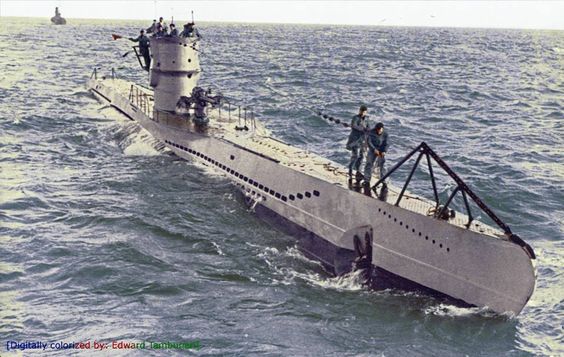 A Type VII C at sea, digitally colorized by Edward Tambunan
A Type VII C at sea, digitally colorized by Edward Tambunan
Type XXVI (1944)
This Type XXVI was a small high-seas model with its bow fitted with the Walter system. The crew was limited to three officers and 30 men. The Type XXVI was armed with ten torpedo tubes: Four forward plus six in the “Schnee organ” arrangement but and no deck guns to keep a streamlined profile. 100 contracts were initially awarded to the Blohm and Voss yard in Hamburg numbered U-4501 to U-4600. Production was indeed started with sections already under construction for the four boats U-4501-U-4504 when the war ended.
Type XXVIIA Hecht (1944)
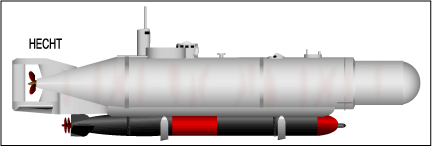
First type of midget submarine, the Hecht were clearly inspired by the British captured X-class boats, and at first were to carry explosive charges too (Hecht). Underpowered, the latter was quickly replaced by the torpedo-carrying U-Boat type XXVIIB, which had two G7e torpedoes and a diesel/electric propulsion for much greater range. Only 53 were built May–August 1944 by Germaniawerft, performing poorly. Indeed only 69 nmi (128 km; 79 mi) at 4 knots (7.4 km/h; 4.6 mph) submerged made for a safety radius of action (meaning a return ticket) of 40 miles at best, or 60 km. But it was the first to carry an operational Gyrocompass in the German Navy.
Type XXVIIB Seehund (1944)
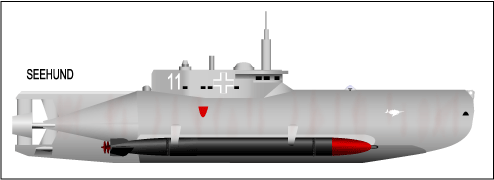
This was an emergency midget model, built by Germaniawerft and Schichau Werke, but also CRD-Monfalcone and Klöckner-Humboldt-Deutz at Ulm. They were 12 m long for 1,68 m wide, 17 tons, electrically powered and capable of 7 knots (13 km/h; 8.1 mph) surfaced and 3 knots (5.6 km/h; 3.5 mph) submerged. Range up to 500 km or 310 miles which allowed coastal operations over 150 miles to have a chance to return safely. They had a crew of two and carried two G7e torpedoes. Over 1,000 were planned, but 285 completed, 138 only were active while 38 were lost. Several has been preserved. The first attack was carried from IJmuiden in the Netherlands on 31 December 1944 and 142 sorties were made until April 1945, sinking tonnage ranging from 93,000 to 120,000 gross tons depending on the sources. They were relatively successful as escaping both hydrophone detection and asdic due to their small size. Only their limited performances prevented more damage but they became quite a concern for allied navy staff.
K-Verband Kleinkampfmittel (Midget submarines)
Molch (1944)
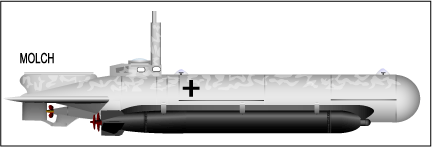
Officially outside the regular U-Boat nomenclature they has been studies, planned, ordered by the K-Verband (“Kleinkampfverbände der Kriegsmarine” or “small battle unit”), a special organism created in march 1944 for naval “spec ops”. The unit also deployed combat swimmers and explosive speed boats.
The first 12 Molch built by AG Weser in Bremen, were operated by the K-Werband 411 during the landings in Provence. They were designed as large torpedoes with a comfortable electric power for short range operations, with a huge Nickel-Cadmium battery allowing 40 nautical miles at 5 knots. In total the 393 built performed 107 sorties until March 1945 and they were also deployed from Antwerp, Holland.
Biber (1944)
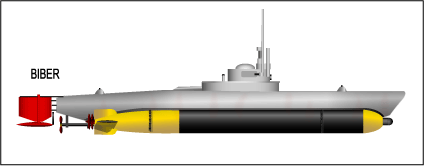
This was the second types of pocket submarine, really small craft for inshore operations, derived from a British mini-sub designed created to blown up moored German and Japanese ships at anchors, inserted with the numerous specs-ops and commando operations of WW2. The Biber differed in many points, like having two torpedoes, not fired but just launched after their engines was started. No less than 324 were built until December 1944 by the Flenderwerke shipyards in Lübeck. They were mostly ineffective in action, sinking just a cargo: about 4500 tons of shipping. Biber II and III were two-seaters paper projects of late 1944.
K-Verband Neger, Marder and Hai (1944)
Neger

This was the desperate step beyond the already cheap and simplified “Kleine Unterseeboote” of the four types seen above (KU). Taking a torpedo and modifying it so to create a single torpedo carrier. This simple trick could on paper generate hundreds of “submarines” for coastal operations, just a couple of hours operations against the allies. These human torpedoes were the idea and design of Richard Mohr from the Kleinkampfverbände. He created first the “Neger” steered torpedo. Operational in March 1944, 200 were built, which had a 88 km range (electric motor able to make them move at 4 knots at best until reaching launching range. Their own torpedo was a classic one, fast-propelled. They operated on 6 June 1944 from Villers-sur-mer and Honfleur, and sank three minesweepers (HMS Cato, Magic and Pylades) and transports, and the 7, badly damaged the Polish cruiser HMS Dragon, to the point she was later sank and used as a breakwater. About 26 arrived on destination out of 30. This was quite a success compared to the first attack at Anzio in March 1944, were all Neger were lost in action.
Marder

This was an improved design, still in 1944, capable of diving up to 40 m. 500 of these were produced until May 1945. The pilot was seated in the nose, seeing through a plexiglas bubble. It was propelled by a 12 hp Electric motor nd barely able to reach 4.2 knots. In operation, for 500 produced, results were meagre at best: Deployed in August 2-4, 1944 from Houlgate, they sank the destroyer HMS Quail, a minesweeper, an LST, a liberty-ship and another transport and damaged a cruiser, but only 17 made it back despite the operation was performed by night. On the 16-17 August, 42 Marders attacked French BB Courbet which took two hits, without much damage, and sank HMS Fratton and a transport for 23 lost. By September 1944 another attack scored no hit but left 17 out of 30 lost in the attack. In the Kriegsmarine, these crafts quickly gained the reputation of “one-way ticket sea coffins”.
Hai

This lengthened Marder was the logical evolution of the type. In contrast to the snail-pace of these crafts, the Hai had bigger batteries, for a top speed of 20 knots which allowed to reach quickly the launching area. This was not only a safety feature but also reduced the fatigue of the single man crew, dizzed often by emanations from the engine, confined atmosphere and bad weather, many fainted due to exhaustion, either en route or on their way back. The Hai was never produced, unlike another derivative with a brand new hull called the Delfin capable of 17 knots and tested in January 1945. All three prototypes were lost during trials.
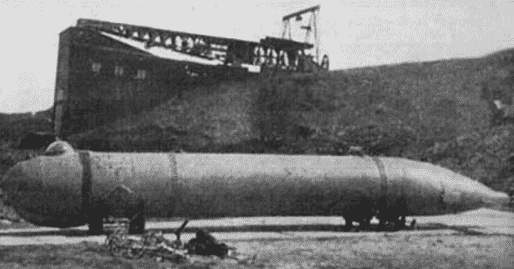
Other projects included the tracked submarine Seeteufel, which could attack from anywhere, and the Schwertval, a Walter engine propelled modified human torpedo. Only a single prototype was built, tested but scuttled in May 1945. It could have been capable of staying indefinitely underwater at 30 knots.
Read More:
http://www.uboataces.com/ref-type.shtml
wikipedia: List_of_U-boat_types
hisutton.com: Uboat_XXIXH
hisutton.com Type-IIIA U-Boat.html
uboat.net: u Boat types
Typology on sudden-strike maps
Uncompleted U-boat projects
Onnaval encyclopedia
The Type XXI On filminspector

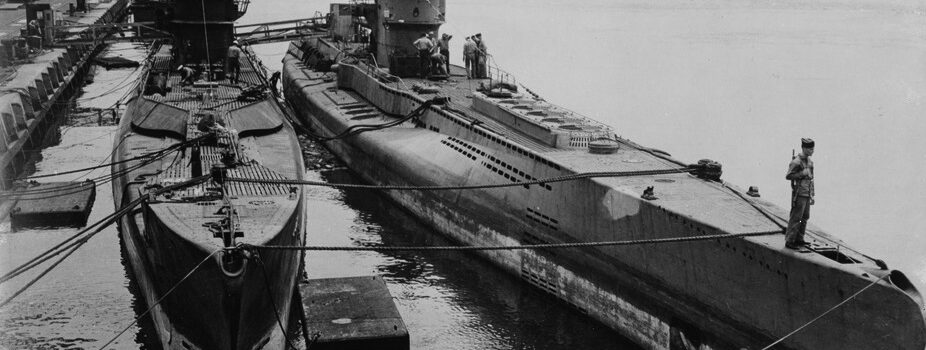
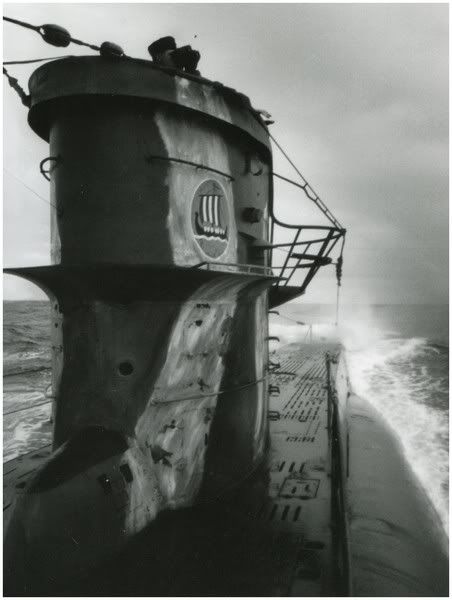
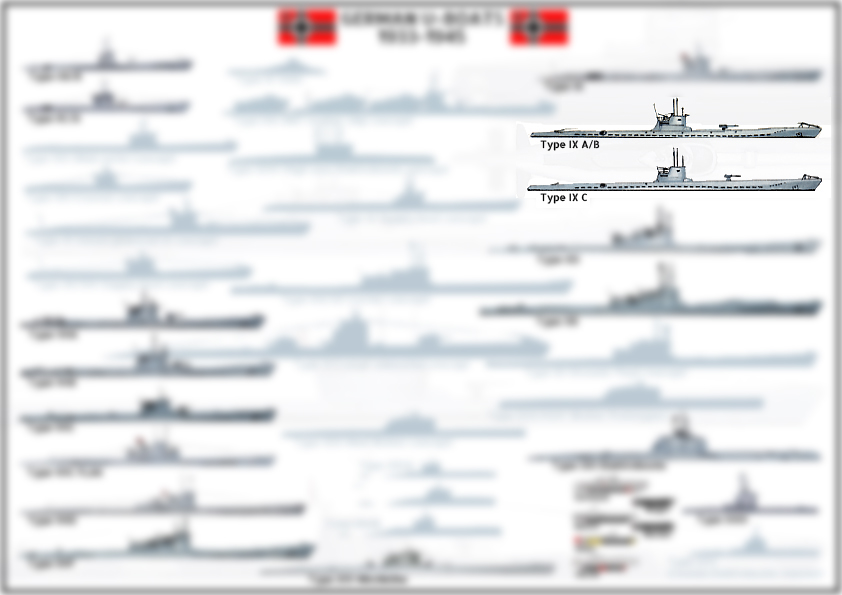
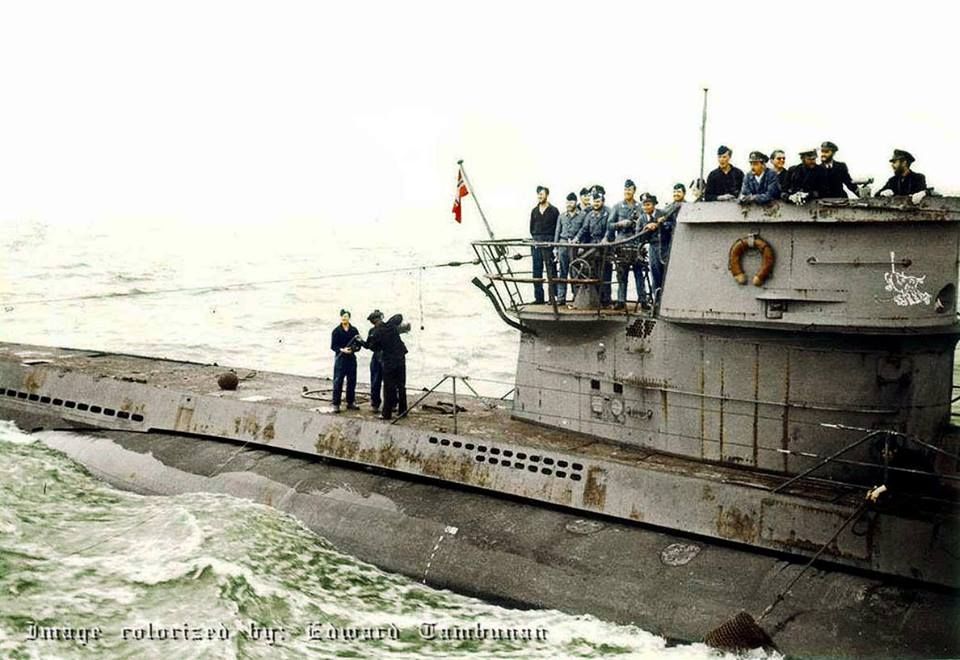
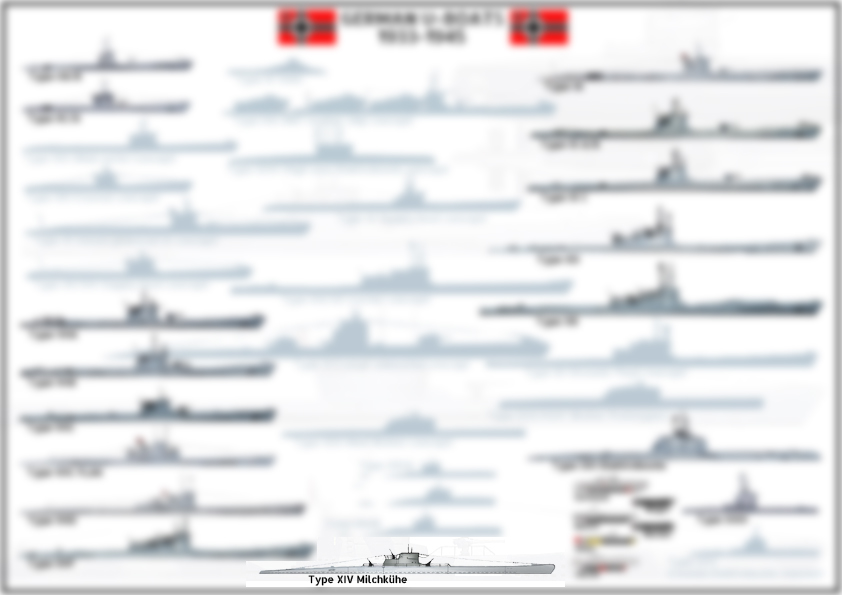
 Latest Facebook Entry -
Latest Facebook Entry -  X(Tweeter) Naval Encyclopedia's deck archive
X(Tweeter) Naval Encyclopedia's deck archive Instagram (@navalencyc)
Instagram (@navalencyc)





 To read for a better understanding of this website
To read for a better understanding of this website Introduction
Introduction Medieval
Medieval Naval Battles
Naval Battles French Navy
French Navy Royal Navy
Royal Navy Russian Navy
Russian Navy Armada Espanola
Armada Espanola Austrian Navy
Austrian Navy K.u.K. Kriegsmarine
K.u.K. Kriegsmarine Dansk Marine
Dansk Marine Nautiko Hellenon
Nautiko Hellenon Koninklije Marine 1870
Koninklije Marine 1870 Marinha do Brasil
Marinha do Brasil Osmanlı Donanması
Osmanlı Donanması Marina Do Peru
Marina Do Peru Marinha do Portugal
Marinha do Portugal Regia Marina 1870
Regia Marina 1870 Nihhon Kaigun 1870
Nihhon Kaigun 1870 Preußische Marine 1870
Preußische Marine 1870 Russkiy Flot 1870
Russkiy Flot 1870 Svenska marinen
Svenska marinen Søværnet
Søværnet Union Navy
Union Navy Confederate Navy
Confederate Navy Armada de Argentina
Armada de Argentina Imperial Chinese Navy
Imperial Chinese Navy Marinha do Portugal
Marinha do Portugal Mexico
Mexico Kaiserliche Marine
Kaiserliche Marine 1898 US Navy
1898 US Navy Sovietskiy Flot
Sovietskiy Flot Royal Canadian Navy
Royal Canadian Navy Royal Australian Navy
Royal Australian Navy RNZN Fleet
RNZN Fleet Chinese Navy 1937
Chinese Navy 1937 Kriegsmarine
Kriegsmarine Chilean Navy
Chilean Navy Danish Navy
Danish Navy Finnish Navy
Finnish Navy Hellenic Navy
Hellenic Navy Polish Navy
Polish Navy Romanian Navy
Romanian Navy Turkish Navy
Turkish Navy Royal Yugoslav Navy
Royal Yugoslav Navy Royal Thai Navy
Royal Thai Navy Minor Navies
Minor Navies Albania
Albania Austria
Austria Belgium
Belgium Columbia
Columbia Costa Rica
Costa Rica Cuba
Cuba Czechoslovakia
Czechoslovakia Dominican Republic
Dominican Republic Haiti
Haiti Hungary
Hungary Honduras
Honduras Estonia
Estonia Iceland
Iceland Eire
Eire Equador
Equador Iran
Iran Iraq
Iraq Latvia
Latvia Liberia
Liberia Lithuania
Lithuania Mandchukuo
Mandchukuo Morocco
Morocco Nicaragua
Nicaragua Persia
Persia San Salvador
San Salvador Sarawak
Sarawak Uruguay
Uruguay Venezuela
Venezuela Zanzibar
Zanzibar The Cold War
The Cold War Warsaw Pact Navies
Warsaw Pact Navies Bulgaria
Bulgaria Hungary
Hungary

 Bundesmarine
Bundesmarine Dutch Navy
Dutch Navy Hellenic Navy
Hellenic Navy Marina Militare
Marina Militare Yugoslav Navy
Yugoslav Navy ASIA
ASIA Chinese Navy
Chinese Navy Indian Navy
Indian Navy Indonesian Navy
Indonesian Navy JMSDF
JMSDF North Korean Navy
North Korean Navy Pakistani Navy
Pakistani Navy Philippines Navy
Philippines Navy ROKN
ROKN Rep. of Singapore Navy
Rep. of Singapore Navy Taiwanese Navy
Taiwanese Navy MIDDLE EAST
MIDDLE EAST IDF Navy
IDF Navy Saudi Navy
Saudi Navy Royal New Zealand Navy
Royal New Zealand Navy Egyptian Navy
Egyptian Navy South African Navy
South African Navy






























 Naval Aviation
Naval Aviation Ukrainian Navy
Ukrainian Navy Naval Landmarks
Naval Landmarks Offshore Platforms
Offshore Platforms Games
Games Modern warships
Modern warships World's Naval Yards
World's Naval Yards About
About Contact
Contact In French
In French Privacy Policy
Privacy Policy Cookie Policy
Cookie Policy dbodesign
dbodesign
1.
Naval encyclopedia: “The Type XXIV U-boats had an electric propulsion on the same style as the Type XXI, but for coastal use. The main reason was also that fossils fuels became a rarity in Germany at the time. This was a 160 ton design but the crew was 58. Armament was limited to two torpedo tubes in the bow.”
Wikipedia: “The Type XXV U-boats were intended to be electric propulsion-only boats for coastal use. The design was 160 tons with a crew of about 58 men and would have had two torpedo tubes fitted at the bow.”
It’s the same U-boat but what’s the right name?
2.
Naval Academy: “type XXV This rather mysterious model was sketched and specifications were written, but it stayed on the initial design phase. The documentation referred to it as an “Advanced coastal boat”.
Wikipedia: “The Type XXIV was a 1943 design for an ocean-going U-boat using the Walter system. It was to have 14 torpedo tubes, six at the bow, and four each side aft.”
Hello Ioan, there are a few sources about thos two, but they are contradicting themselves indeed. I will dig down into these when the website will grow to the point of starting to covering prototypes and paper projects as well. Cheers, David B, NE manager
Hi, The U995 from Laboe is a Typ VII C/41 not VII D, also, it was used by Norway for training after the war and was given back to Germany in 1965.
Ok sir ! fixed, i plan to visit her some day…